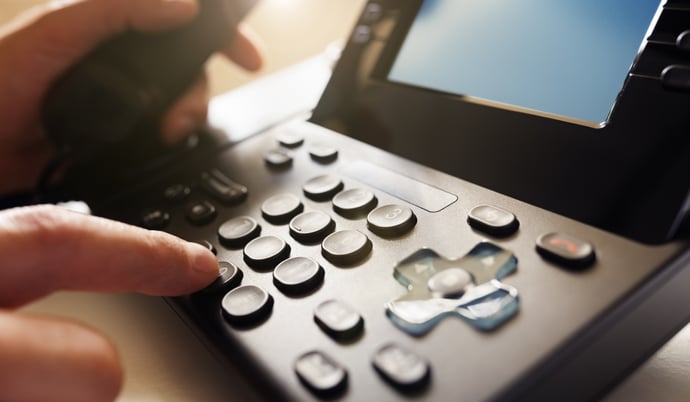
For any modern hotel, VoIP is no longer an optional upgrade. VoIP phone systems offer unparalleled flexibility, features, and upgradeability, all for a lower monthly cost than a traditional analog system.
Nevertheless, some hoteliers are still hesitant to make the shift to a VoIP system. Hotels need to be operational and responsive around the clock, making the prospect of downtime understandably daunting. To ease these concerns and ensure a successful installation, outlined below are key considerations to review ahead of a VoIP system upgrade.
1. Test Your Network and Internet Connection
Unlike an analog system, VoIP phones work over the same internet connection that your hotel’s other online functionalities use. This saves on monthly costs, installation, and maintenance.
To ensure your hotel is set up for a VoIP system, your internet connection needs to be capable of carrying a phone signal from every trunk in your hotel simultaneously. Luckily, a VoIP call takes a relatively small amount of bandwidth, only 100 kilobits per second, to achieve a crystal-clear voice signal.
In a hotel with 250 phone trunks, this requires roughly 3.125 megabits per second of bandwidth to accommodate calls on every trunk at once. We generally recommend that your phone bandwidth only occupy about 20 percent of your hotel’s total bandwidth, allowing enough overhead for internet usage and video streaming. To accommodate, a hotel with 250 phone trunks should have a minimum internet connection speed of 15 Mbps.
Your internal network is also a consideration. To function optimally, VoIP handsets require a strong wi-fi connection. It’s recommended to test the strength of your wi-fi signal throughout your hotel and consider installing low-cost wi-fi repeaters or extenders if necessary to guarantee a strong connection in every room.
2. Invest in the Right Hardware
Once your VoIP phone system is in place, you’ll need physical hardware to connect to your network and make phone calls. You have several options:
- VoIP phones: dedicated VoIP phones are designed to connect directly to wi-fi or hardline Ethernet cables. VoIP phones allow you and your guests to take advantage of all the features of your VoIP system in addition to just placing and receiving calls.
- VoIP adapters: if you have a hotel full of traditional phones and don’t want to replace them all at once, you can purchase adapters that will convert typical phone jacks (RJ-11) to wifi or Ethernet connections. This will allow your existing analog phones to place calls over your VoIP network, but you won’t be able to use the full suite of features.
- Softphones: if you already have a computer at the front desk or your manager carries a smartphone, you can simply install software that adds VoIP calling functionality to the computer or smartphone with no extra hardware required.
In addition to the phone handsets themselves, you might need to invest in extra hardware like high-speed wireless routers and range extenders to ensure a reliable internet connection throughout the facility.
3. The Engineering and Installation Process
When you purchase a VoIP system from Phonesuite, you’re signing up for industry-leading technical expertise and installation to ensure minimal downtime and interruption to the daily operations of your hotel. We’ve created a proprietary six-stage process to install our Phonesuite system, all of which will be spelled out in your contract and overseen by one of our dedicated Project Managers.
- Information Gathering: we’ll start with an assessment to identify your goals and needs, then determine which Phonesuite system will best serve your needs.
- Design: our engineers will review your existing network and telephony requirements to ensure that we can easily integrate our Managed VOICE platform into your infrastructure without compromising on your communications needs.
- Pre-installation: a Lead Sales Account Manager will be your liaison between Phonesuite and your hotel, while our deployment team will answer any concerns you may have about the installation process. We’ll schedule a meeting to explain the installation process so you know exactly what to expect.
- Onsite Deployment: a project manager, lead onsite engineer, remote tier 3 engineer, and local factory-trained techs will install any hardware that your system requires.
- QA and Testing: we’ll test every feature and functionality of your new Phonesuite system, making test calls and running through a checklist with onsite hotel staff. We’ll also conduct training to familiarize your staff with the features and functionality of the new system, including general operation, the browser console, the configurator, and reporting.
- Support: after the installation, our support system includes:
- 24/7 Proactive Monitoring and Factory-Maintained Call Center.
- Lifetime “No Questions Asked” Warranty on all Phonesuite manufacture equipment.
- Upgrades on all Phonesuite manufactured hardware and software.
- Free Move, Adds, and Changes (MAC) configuration changes
- Free daily encrypted backups for “peace of mind” disaster recovery
- Rapid Call Center and Onsite Response
4. Train Your Staff
To fully take advantage of the suite of features that a VoIP system offers, your staff will require training to familiarize themselves with the functionality of the new system.
Your new system might include new features like CRM integration, custom routing, the ability to forward voicemails to emails, and more. To provide your guests with the most efficient, high-tech experience possible, you’ll want to ensure your staff is fully trained and comfortable with the additional features of your new phone system.
Talk to Phonesuite Today
If you’re ready to make the switch to a complete VoIP system, talk to Phonesuite today. Our phone system was built from the ground up for the unique guest and business needs of hotels, and we’ve installed our systems in thousands of hotels of all sizes all over the world. We’ll discuss your needs, explain the costs, and give you an overview of the installation process so you know exactly what to expect.

